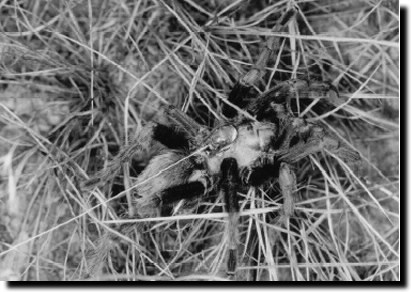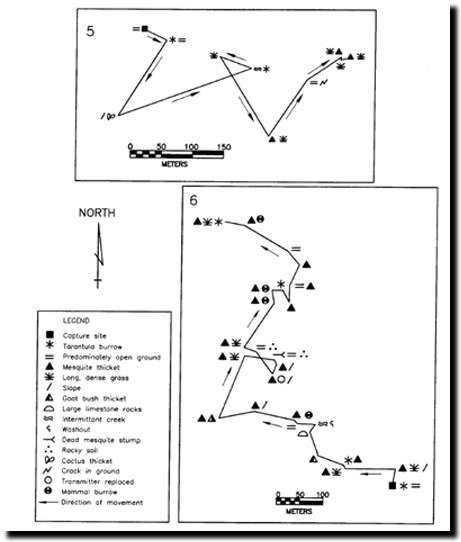Nojoqui Tarantula Migration DxPeditions
The Annual Nojoqui Tarantula
Migration Dxpedition: Each year, thousands of tarantulas
brave countless dangers as they migrate to their ancestral breeding grounds
somewhere in northern Santa Barbara county. The journey, which is believed
to span some 50 miles across treacherous terrain and several county highways,
is one of the most unusual mass migrations. Once
thought to be only myth, the Nojoqui Tarantulas have recently been rediscovered
and their great migration the source of scientific wonder and amazement.
Thought to be related to the Amazon tarantula, the Nojoqui
tarantula's origins are unknown. Stories past down from Nojoqui locals
depict a series of strange and mysterious events related to the annual migration:
- In 1864, the rotting remains of a herd of cattle
that happened to wander into the migration path, were found nearly
completely consumed. Once thought to only consume leafy green
vegetable matter, it is believed that the tarantulas went on a feeding
frenzy prompted by an usually dry summer that depleted the local fauna.
- In 1912, thousands of tarantulas were found crushed
and buried in a landslide that occurred during the night of the migration.
A fierce thunderstorm caused one of the hillsides in the migration
path to give way burying thousands of tarantulas under tons of debris. There
had been no reports of thunderstorms or landslides in the area either before
that night or since.
- In 1947, a local rancher installed an electric fence
along his property. The fence happened to be in the migration path that
year. The tarantulas attempted to cross over the fence by building
a bridge with their bodies. The increased load on the electrical system
ignited fires along the fence and the local electrical substation, plunging
the entire central coast of California into a blackout and igniting one
of the largest brush fires in Santa Barbara history.
This year, we have good information on when and where
the migration will occur. Local Nojoqui's who claim to know, have told
us that this year's migration might be the largest in numbers of the past 50
years. Over the past several years, migrations have been dwindling, prompting
some scientists to speculate that the Nojoqui tarantulas might be perilously
close to extinction. Locals have told us that building development near
the breeding grounds may be responsible for the recent decline.

However, upon further examination, I have found that the
sightings of mass numbers of migrating tarantulas closely follows the sunspot
cycle. Most amateurs will quickly recognize the graphic on the left. The
red dots indicate the relative size of recent tarantula migratory numbers superimposed
on the sunspot cycle as reported by NOAA in Boulder Colorado.
Clearly, with only limited empirical data, further study
must be undertaken to determine if there is a link between the xray solar flux
and the migration patterns of the Nojoqui tarantulas. But the graphic
seems to imply that the locals might be wrong in their assessment of
current tarantula numbers. If the data is correct, this year's migration
should be approaching the low numbers of 1997 and not the massive event
that has been talked about in recent weeks around Nojoqui.
We have not yet obtained the necessary permitting. We
do not want to attract hundreds of observers for fear of putting unsuspecting
tourists in harm's way. We certainly do not want a headline in the local
papers linking our hobby to a series of unfortunate incidents during the migration.
So, we just might go in under the radar and set up just after any initial
sightings of the migration are reported.
PRIOR SCIENCE

No, your eyes aren't playing tricks on you. Yes,
that's a radio antenna attached to this male tarantula. Actually, it's
a favorite among tarantulas: Aphonopelma Hentzi (ARANEAE, THERAPHOSIDAE),
a male brown tarantula. In 1999 a study was conducted to gain insight
into the migratory life history component of the male brown tarantula, Aphonopelma
hentzi (shown above), and to determine if radio telemetry could successfully
answer questions regarding the ecology of theraphosids. Tarantulas were equipped
with radio transmitters and their movement monitored using an antenna and radio
receiver. Overall movement of males was in all directions and randomness could
not be excluded as a factor. Individual males moved relatively large distances,
up to 1300m, and significant directedness was only found in three individuals.
 Later
it was discovered that these three unique theraphosids were actually once the
personal property of Phoenix resident Johnny Saulisco. Young Mr. Saulisco
apparently grew tired of his three pets and released them back into the wild
approximately a year before the study. Apparently, Johnny used the three
in a science fair project entitled "Do Tarantulas Have A Trial and Error
System?" He had devised a series of mazes the tarantulas needed to
navigate in order to get to the female tarantula. There were six choices
in the form of paths leading to six chambers wherein the female lay. However,
Johnny only put two females and four other males in the six rooms. He
repeatedly tested his pets. Frustrated that they didn't seem to figure
it out, he concluded the answer was "no" and later released them back
into the wild. Later
it was discovered that these three unique theraphosids were actually once the
personal property of Phoenix resident Johnny Saulisco. Young Mr. Saulisco
apparently grew tired of his three pets and released them back into the wild
approximately a year before the study. Apparently, Johnny used the three
in a science fair project entitled "Do Tarantulas Have A Trial and Error
System?" He had devised a series of mazes the tarantulas needed to
navigate in order to get to the female tarantula. There were six choices
in the form of paths leading to six chambers wherein the female lay. However,
Johnny only put two females and four other males in the six rooms. He
repeatedly tested his pets. Frustrated that they didn't seem to figure
it out, he concluded the answer was "no" and later released them back
into the wild.
Apparently, the limited exposure to a learned environmental
response in captivity was enough to differentiate the behavior between domesticated
and wild tarantulas in a blind test.
Fearing the contamination of the local tarantula gene
pool by human forces, the Phoenix County Board of Supervisors adopted a "no
release of captive theraphosids" or any other 'desert pets' back into the
wild policy. "We've seen what can happen when human planted grasses
invade the hillsides. We're not going to let that happen to our tarantulas
and other desert local populations."
It appeared that this policy was successful in averting
an ecological disaster, based on the levels of tramatic compaction syndrome
seen on the local roads and highways in and around Phoenix.
TARANTULA
MIGRATION INTERVIEW ON KYTD RADIO
2006
Migration
|

 Get
your official 2008 Nojoqui Tarantula Migration stuff
here!
Get
your official 2008 Nojoqui Tarantula Migration stuff
here!